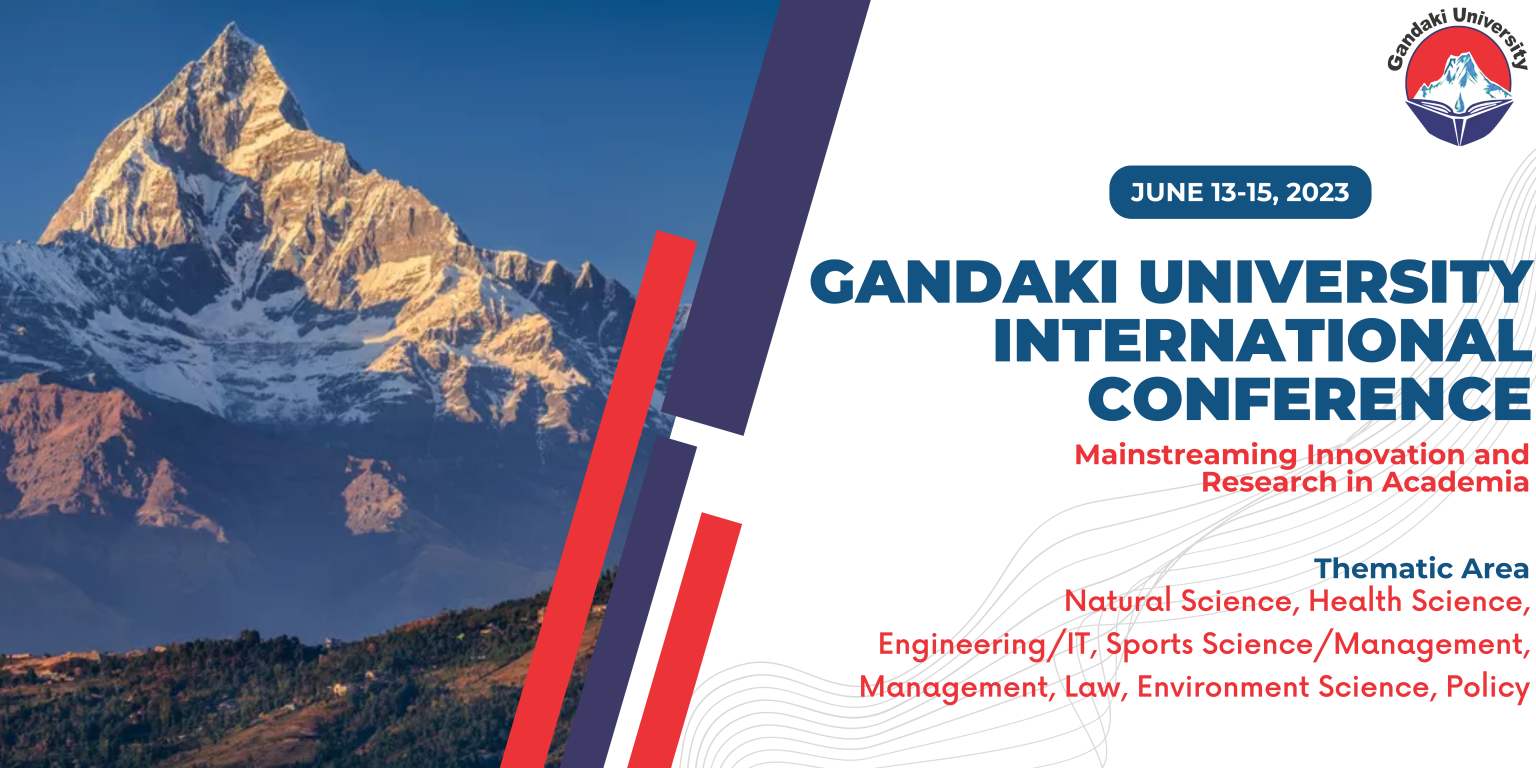
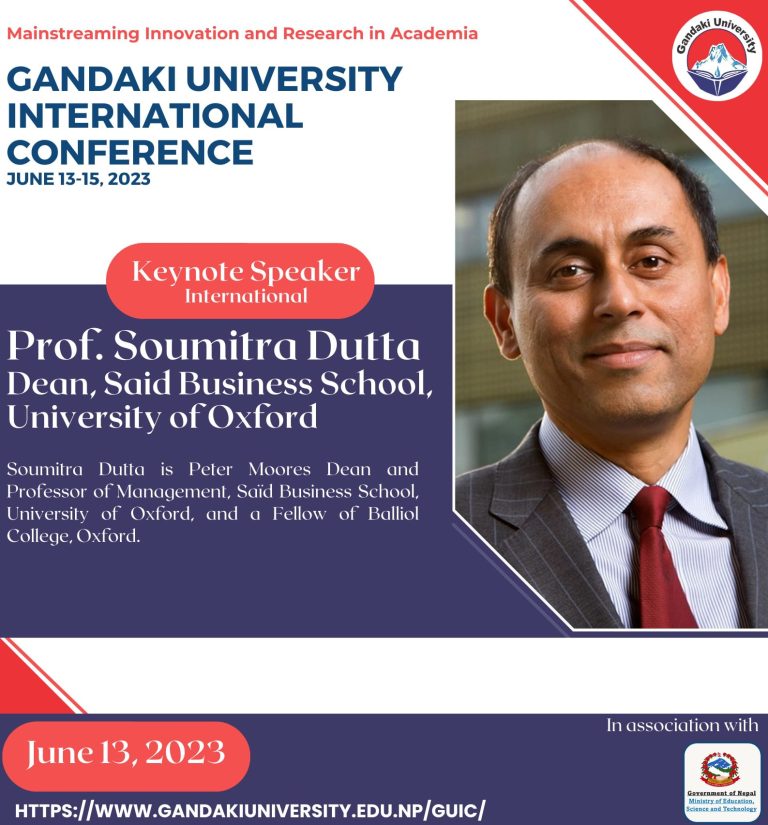
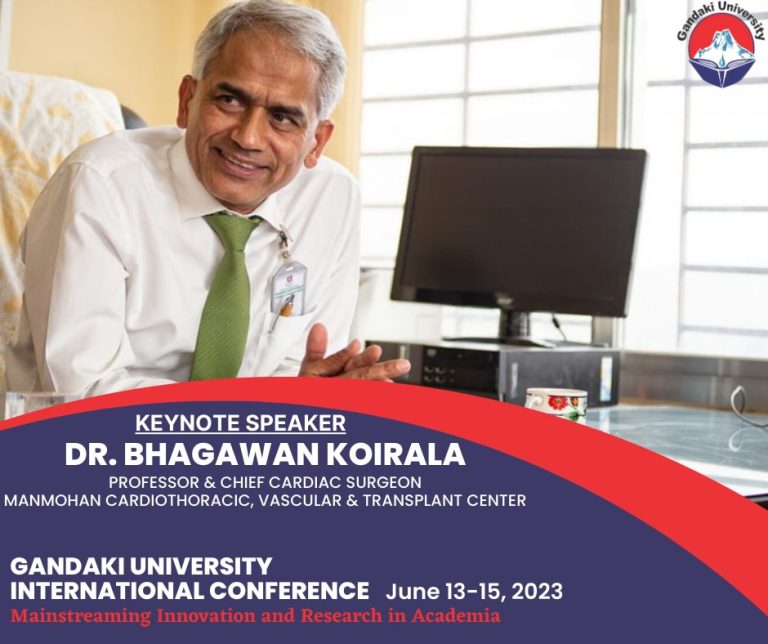
- About Gandaki University
- About GUIC
- Thematic Areas
- Key Dates
- Venue
- Registration
- Abstract Submission
- Presentation Format
- Conference Proceedings
- Conference Office
- Partnership
- Travel Information
- Advisory Board
- Organizing Committee
- Scientific Committee
Gandaki University (GU) is a newly established university located in Pokhara, a beautiful city in Nepal that is known for its stunning natural surroundings. The university was founded in 2019 with the aim of providing world-class education that is in line with the latest international trends in university education. One of the key features of GU is its interdisciplinary approach to teaching, which enables students to pursue a diverse range of subjects and develop a well-rounded education.
At GU, the focus is on student-centered pedagogical approaches that are designed to help students meet their lifelong goals and dreams. The university is committed to fostering quality education that adheres to democratic values and high ethos. With the brand mission of “Welcome to the Future”, GU aims to be a leading national center for excellence in higher education in Nepal and to rank among the top universities in the world.
One of the strategic goals of GU is to provide a new direction for the students’ future. The university is committed to advancing society through knowledge, and it seeks to equip students with the skills and knowledge they need to take the lead for peaceful living in chaotic situations. To achieve this goal, GU plans to introduce a broader framework and direction that will guide students on their life trajectory.
In addition to its academic mission, GU is also committed to creating a congenial space for teaching and research to meet the growing demands of the global context. The university aims to foster an environment of togetherness, collectivism, friendship, and ownership among its stakeholders, including students, faculties, administrative staff, locals, government, advocacy groups, NGOs, civil societies, INGOs, business communities, and beyond. With this commitment, GU is poised to become a leading force in higher education in Nepal and beyond.
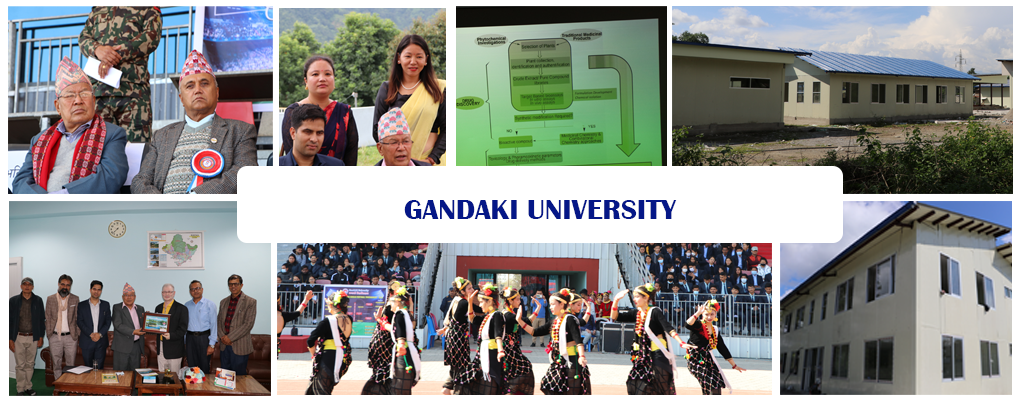
The Gandaki University International Conference (GUIC) is an annual event that brings together scholars, researchers, students, and professionals from around the world to discuss and exchange ideas on a wide range of topics related to the conference theme. The conference is hosted by Gandaki University, a leading national center for excellence in higher education in Nepal. The conference provides a platform for academics and practitioners to share their research findings, explore emerging trends, and discuss challenges and opportunities in their respective fields. The conference features keynote speeches by distinguished scholars, paper presentations and poster sessions.
The conference theme varies from year to year and reflects current trends and issues in various academic disciplines. The conference provides a unique opportunity for participants to engage in interdisciplinary conversations and collaborations that can lead to new research agendas, policy initiatives, and practical solutions to pressing problems. The conference is open to scholars, researchers, students, and professionals from all over the world who are interested in contributing to the advancement of knowledge and the improvement of the human condition. Participants are invited to submit abstracts and papers for consideration, and selected papers are published in conference proceedings or in special issues of academic journals.
GUIC is an exciting and intellectually stimulating event that offers a unique opportunity to engage with scholars and professionals from diverse backgrounds and perspectives. The conference is an important part of Gandaki University’s commitment to fostering quality education and promoting the exchange of knowledge and ideas across borders and disciplines.
- Natural Science
- Health Science
- Engineering/IT
- Sports Science/Management
- Management
- Law
- Environment Science
- Policy

Key Dates
- March 15 – April 30, 2023 (Chaitra 1, 2079 – Baisakh 17, 2080)
Abstract submission for oral and poster presentation - May 3, 2023 (Baisakh 20, 2080)
Notification of acceptance - April 14 – May 3, 2023 (Baisakh 1-20, 2080)
Early bird Registration - May 4-24, 2023 (Baisakh 21 – Jestha 10, 2080)
Late registration - June 13-15,2023 (Jestha 30-32, 2080)
Conference Days

Conference Venue:
Hotel Jal Mahal
Gharipatan (Behind Airport), PokharaPhone: ( +977 61 456652, 457448 (o)Cell: +977 9856087030, 9856087031 Link: https://www.jalmahalpokhara.com/
- Pokhara, known as the “City of Lakes”, is a place of unrivaled natural beauty that captivates the hearts of visitors from all over the world. Whether you are a first-time visitor or have been to Pokhara many times before, the breathtaking scenery never fails to leave a lasting impression. The city is nestled in the lap of the Fishtail and Annapurna Mountains and surrounded by crystal clear lakes and lush green forests. The majestic Himalayas provide a stunning backdrop to the city, which is a hub of adventure and culture.
It is hard not to be mesmerized by the beauty of Pokhara’s landscapes, from the peaceful Phewa Lake to the vibrant Davis Falls. The city’s vibrant atmosphere and friendly locals make it a welcoming and warm destination that never fails to inspire visitors. The city’s rich history is also an important part of its charm, with ancient temples and monuments that have stood the test of time. The tranquil environment of the city provides a perfect escape from the hustle and bustle of modern life, while the adventurous spirit of the city is perfect for those seeking new experiences.
In short, Pokhara is a city that will leave you awe-inspired and rejuvenated, with its natural beauty, rich cultural heritage, and warm hospitality. It is a city that you will never tire of exploring, and a destination that will stay with you long after you leave.
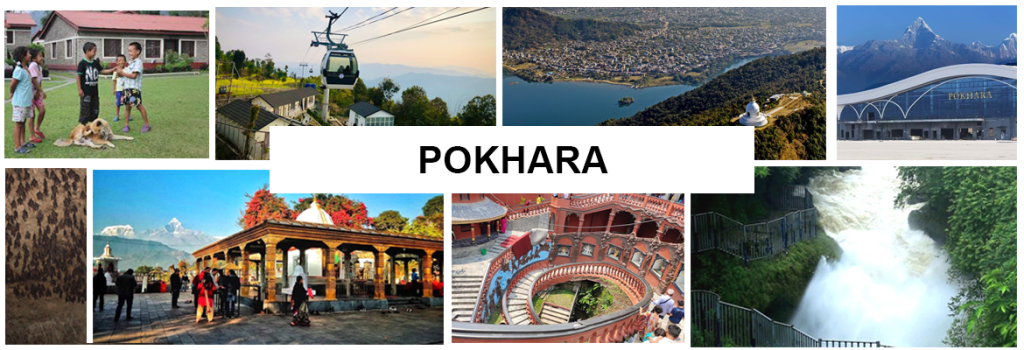
- Early bird: April 14 – May 3, 2023 (Baisakh 1-20, 2080)
- Late registration: May 4 – May 24, 2023 (Baisakh 21 – Jestha 10, 2080)
- On-site registration: Possible
- Registration fees non-refundable for cancellations.
- Registration fees
| S. No. | Registration type | Early bird | Late registration | On-site registration |
| 1. | Student (Nepal) | NRs. 1500 | NRs. 2000 | NRs. 2500 |
| 2. | Faculty (Nepal) | NRs. 3000 | NRs. 3500 | NRs. 4000 |
| 3. | Regular participant (Presenter and non-presenter) (Nepal) | NRs. 3000 | NRs. 3500 | NRs. 4000 |
| 4. | SAARC Country student participant | $50 | $75 | $100 |
| 5. | SAARC Country regular participant | $100 | $150 | $200 |
| 6. | International student participant | $100 | $150 | $200 |
| 7. | International regular participant | $150 | $200 | $250 |
Payment :
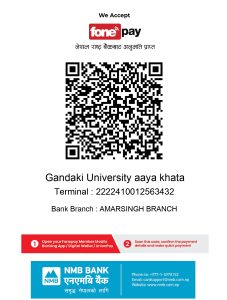
- Call for papers
- Abstract submission for oral and poster presentations: March 15 – April 30, 2023 (Chaitra 1, 2079 – Baisakh 17, 2080)
- Notification of acceptance by: May 3, 2023 (Baisakh 20, 2080)
- Abstract Format
- Be written in English
- Include a title allocated to a specific Theme, Topic and Sub-topic; title limited to 20 words in UPPER CASE
- Have all author names and contact details (Author and co-authors’ details: Full first and family names, affiliation details: department, institution, city, state, country; Correspondence: Email address, full postal address, phone number)
- Have a word count of 150-250 words (excluding title, key words, and references)
- Have abstract layout as: Objectives, Methods, Results and Conclusions
- Include 3-5 key words
- Indicate whether the submission is for oral or poster presentation
- Use Times New Roman, 14 font, bold for the title; and Times New Roman, 12 font for the authors, affiliation and text of the abstract. Follow APA style referencing
- References are not obligatory and word count is affected by inclusion of references
- Tables – A maximum of 2 tables of up to 5 rows x 5 columns can be included per abstract
- Graphs and images – A maximum of 2 images can be included per abstract (the maximum file size of each graph/image should be 500 KB)
- Abstract Review
- A scientific committee will review all submitted abstracts.The final decision, however, lies with the Scientific Committee. Notification regarding abstract acceptance and scheduling will be sent to the submitting author.
- Invited presentation Invited presentations are presented by invited speakers in PowerPoint format. Invited presentations last 30 minutes, followed by 10 minutes of Q&A. One hour before the presentation, invited presentations must be pre-uploaded in the Speakers Ready Room. While using your own USB is allowed, using your own laptop is not allowed. Abstracts must be submitted in accordance with the Guidelines established by Gandaki University International Conference.
- Oral presentation PowerPoint is the format for oral presentations. There will be a 15-minute oral presentation period and a 5-minute discussion period. One hour before the presentation, oral presentations must be pre-uploaded in the Speakers Ready Room. While using your own USB is allowed, using your own laptop is not allowed.
- Time limit: 15 minutes, followed by a 5-minute question and answer session.
- Content: A clear and concise introduction, followed by an overview of the research methodology, results, and conclusions. It’s important to emphasize the significance of research and how it contributes to the field.
- Visual Aids: A maximum of 15-20 slides is recommended. Use high-quality visuals that are easy to read and understand.
Guidelines for Poster presentation
-
- Content: The poster should include an abstract, introduction/objective, methods, results, conclusion and references. The content should be presented in a clear and concise manner that is easy to understand.
- Visual Aids: Use clear and high-quality visuals, such as graphs, charts, and images, to support the content. The poster should be visually appealing and easy to read from a distance.
- Layout: Use a clear and organized layout that guides the reader through the content. The poster should be easy to follow and understand. The layout should be in accordance with the guidelines of Gandaki University International Conference.
- Poster Size: Maximum 3 feet width and 5 feet length with,
- Prepare a 10-30 cm high headline strip with the title, author(s) and affiliation(s) that runs the full width of the poster
- Author should print and bring their poster to conference site by themselves
- Presenter should finish registration for the conference
- Poster should be attached at the space provided for individual presenter at scheduled times
- Author should be present at their poster during poster presentation session
- Sticky tapes, pins or thumb tacks for attaching poster will be provided by the organizer at the time of conference
- Poster should be removed by presenter(s) after the end of poster presentation time
GUIC provides a platform for scholars, researchers, and experts from different fields to exchange ideas, present their latest research findings, and discuss emerging trends in their respective disciplines. The conference proceedings serve as a valuable resource for scholars and students alike, providing access to cutting-edge research and insights from leading experts in various fields. With a focus on interdisciplinary collaboration and student-centered pedagogical approaches, the conference proceedings of GUICwill contribute to the advancement of knowledge and the development of innovative solutions to pressing global challenges.All accepted and presented abstracts (oral or poster) will be published in the conference proceedings.
Address:Gandaki Province, Mustang Chowk, Pokhara, Kaski, Nepal
Mobile Phone:……………………..
Email:[email protected]
Website: https://www.gandakiuniversity.edu.np/guic
Registration desk on-site opening hours
Tuesday: 10.00am to 5.00 pm
Wednesday: 10.00am to 5.00 pm
Thursday: 10.00am to 2.00 pm
Comming Soon…..
The most convenient way to reach Pokhara is by air, as Pokhara has its own domestic airport with regular flights from Kathmandu and other major cities in Nepal. Alternatively, you can also reach Pokhara by road, as there are several bus services that operate between Pokhara and major cities in Nepal.
Prof. Dr. Ganesh Man Gurung, Chancellor, Gandaki University
Prof. Dr. Naba Raj Devkota, Vice-Chancellor, Gandaki University
Dr. Kailash Timilsina, Registrar, Gandaki University
Dr. Kapil Adhikari, Dean, Faculty of Science and Technology, Gandaki University
- Dr. Kisan Koirala, Controller of the Examinations, Gandaki University
- Mr. Ravi Bhandari, Head, IRDA, Gandaki University
- Dr. Madhu Sudhan Subedi, Coordinator, BSM, Gandaki University
- Dr. Sushil Bhandari, Assistant Professor, B. Pharm, Gandaki University
National
- Dr. Raj Kumar Thapa, Executive Director, Research Center, Invention and Innovation Center (RC-II), Gandaki University, Nepal
- Dr. Kisan Koirala, Controller of the Examinations, Gandaki University, Nepal
- Mr. Ravi Bhandari, Head, International Relations and Development Affairs (IRDA), Gandaki University, Nepal
- Dr. Madhu SudhanSubedi, Coordinator, Sports Management Program, Gandaki University, Nepal
- Mr. Prakash Poudel, Coordinator, Pharmacy Program, Gandaki University, Nepal
- Mr. Sagar Raj Poudel, Assistant Professor, Gandaki University, Nepal
- Dr. NamrajDhami, Executive Director, Pokhara University Research Center, Nepal
- Dr. Dhaka Ram Bhandari, Executive Director, Gandaki Province Academy of Science and Technology, Nepal
- Prof. Dr. Vikash KC, Prithvi Narayan Campus, Tribhuvan University, Nepal
- Dr. Ripu Kunwar, Nepal-NAP Project, Nepal
- Dr. Bimala Sharma, Associate Professor, Gandaki Medical College, Tribhuvan University, Nepal
- Dr. Rajib Pokhrel, Associate Professor, School of Engineering, Pokhara University
- Dr. Prabij Joshi, Assistant Professor, Institute of Engineering, Paschimanchal Campus, Pokhara, Nepal
- Prof. Dr. Binaya Kumar Mishra, School of Engineering, Pokhara University
- Dr. Bhupendra Bimal Chhetri, Department of Electrical and Electronics Engineering, Kathmandu University, Nepal
- Madhav Prasad Ghimire, Central Department of Physics, Tribhuvan University, Nepal
- Dr. Narayan Adhikari, Central Department of Physics, Tribhuvan University, Kathmandu, Nepal
- Dr. Krishna Raj Adhikari, Associate Professor, Paschimanchal Campus, Institute of Engineering, Tribhuvan University, Nepal
- Dr. Nurapati Pantha, Associate Professor, Central Department of Physics, Tribhuvan University, Nepal
- Dr. Som Nath Sapkota, Research Director, Department of Mines and Geology, Nepal
International
- Prof. Dr. Medani Bhandari, Vice President of Academics, Akamai University, US
- Dr. Hari Devkota, Assistant Professor, Kumamoto University, Japan (Adjunct Professor, Gandaki University, Nepal)
- Dr. Subrata Sinha, Assistant Professor, Dibrugarh University, India (Adjunct Professor, Gandaki University, Nepal)
- Dr. Jason Powell, Provost, Crescent College, UK (Adjunct Professor, Gandaki University, Nepal)
- Dr. Walter Mswaka, Rollins College, UK (Adjunct Professor, Gandaki University, Nepal)
- Prof. Dr. G. Hari Harindranath, School of Business and Management, Royal Holloway, University of London, UK
- Eunhwa Choi, PhD, Principal Researcher, Environment Research Group, Research Institute of Industrial Science and Technology, Republic of Korea
- Dr. Ravindra Pathak, Associate Professor of Mechanical Engineering at Medi-Caps University India